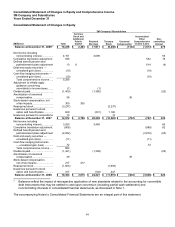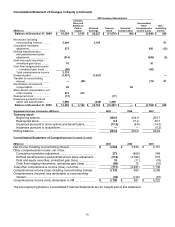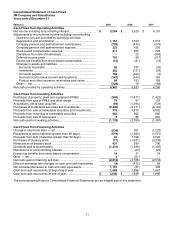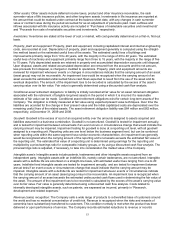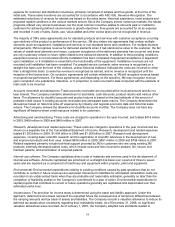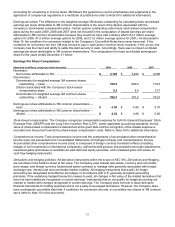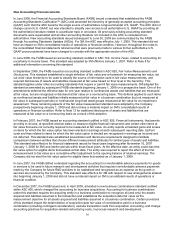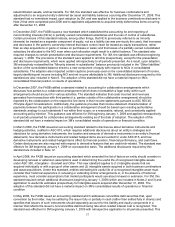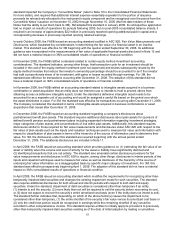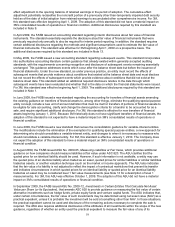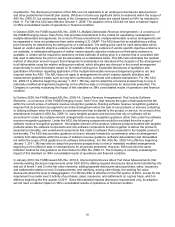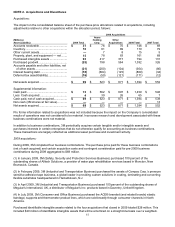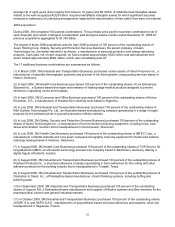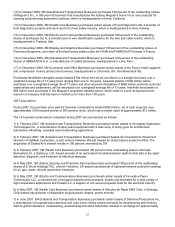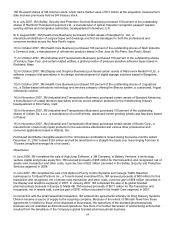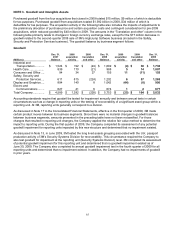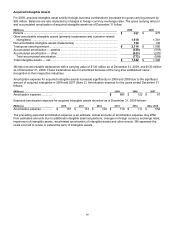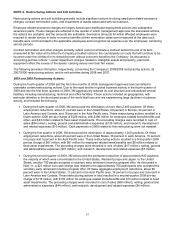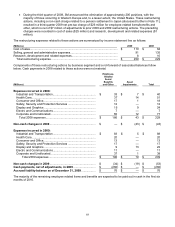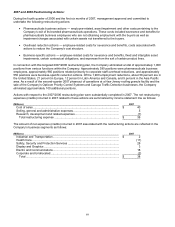3M 2009 Annual Report Download - page 65
Download and view the complete annual report
Please find page 65 of the 2009 3M annual report below. You can navigate through the pages in the report by either clicking on the pages listed below, or by using the keyword search tool below to find specific information within the annual report. 59
effect adjustment to the opening balance of retained earnings in the period of adoption. The cumulative-effect
adjustment potentially reclassifies the noncredit portion of a previously other-than-temporarily impaired debt security
held as of the date of initial adoption from retained earnings to accumulated other comprehensive income. For 3M,
this standard was effective beginning April 1, 2009. The adoption of this standard did not have a material impact on
3M’s consolidated results of operations or financial condition. Additional disclosures required by this standard are
included in Note 9.
In April 2009, the FASB issued an accounting standard regarding interim disclosures about fair value of financial
instruments. The standard essentially expands the disclosure about fair value of financial instruments that were
previously required only annually to also be required for interim period reporting. In addition, the standard requires
certain additional disclosures regarding the methods and significant assumptions used to estimate the fair value of
financial instruments. This standard was effective for 3M beginning April 1, 2009 on a prospective basis. The
additional disclosures required by this standard are included in Note 13.
In May 2009, the FASB issued a new accounting standard regarding subsequent events. This standard incorporates
into authoritative accounting literature certain guidance that already existed within generally accepted auditing
standards, with the requirements concerning recognition and disclosure of subsequent events remaining essentially
unchanged. This guidance addresses events which occur after the balance sheet date but before the issuance of
financial statements. Under the new standard, as under previous practice, an entity must record the effects of
subsequent events that provide evidence about conditions that existed at the balance sheet date and must disclose
but not record the effects of subsequent events which provide evidence about conditions that did not exist at the
balance sheet date. This standard added an additional required disclosure relative to the date through which
subsequent events have been evaluated and whether that is the date on which the financial statements were issued.
For 3M, this standard was effective beginning April 1, 2009. The additional disclosures required by this standard are
included in Note 1.
In June 2009, the FASB issued a new standard regarding the accounting for transfers of financial assets amending
the existing guidance on transfers of financial assets to, among other things, eliminate the qualifying special-purpose
entity concept, include a new unit of account definition that must be met for transfers of portions of financial assets to
be eligible for sale accounting, clarify and change the derecognition criteria for a transfer to be accounted for as a
sale, and require significant additional disclosure. For 3M, this standard is effective for new transfers of financial
assets beginning January 1, 2010. Because 3M historically does not have significant transfers of financial assets, the
adoption of this standard is not expected to have a material impact on 3M’s consolidated results of operations or
financial condition.
In June 2009, the FASB issued a new standard that revises the consolidation guidance for variable-interest entities.
The modifications include the elimination of the exemption for qualifying special purpose entities, a new approach for
determining who should consolidate a variable-interest entity, and changes to when it is necessary to reassess who
should consolidate a variable-interest entity. For 3M, this standard is effective January 1, 2010. The Company does
not expect the adoption of this standard to have a material impact on 3M’s consolidated results of operations or
financial condition.
In August 2009, the FASB issued ASU No. 2009-05, Measuring Liabilities at Fair Value, which provides additional
guidance on how companies should measure liabilities at fair value under ASC 820. The ASU clarifies that the
quoted price for an identical liability should be used. However, if such information is not available, a entity may use
the quoted price of an identical liability when traded as an asset, quoted prices for similar liabilities or similar liabilities
traded as assets, or another valuation technique (such as the market or income approach). The ASU also indicates
that the fair value of a liability is not adjusted to reflect the impact of contractual restrictions that prevent its transfer
and indicates circumstances in which quoted prices for an identical liability or quoted price for an identical liability
traded as an asset may be considered level 1 fair value measurements (see Note 13 for a description of level 1
measurements). For 3M, this ASU was effective October 1, 2009. The adoption of this ASU did not have a material
impact on 3M’s consolidated results of operations or financial condition.
In September 2009, the FASB issued ASU No. 2009-12, Investments in Certain Entities That Calculate Net Asset
Value per Share (or Its Equivalent), that amends ASC 820 to provide guidance on measuring the fair value of certain
alternative investments such as hedge funds, private equity funds and venture capital funds. The ASU indicates that,
under certain circumstances, the fair value of such investments may be determined using net asset value (NAV) as a
practical expedient, unless it is probable the investment will be sold at something other than NAV. In those situations,
the practical expedient cannot be used and disclosure of the remaining actions necessary to complete the sale is
required. The ASU also requires additional disclosures of the attributes of all investments within the scope of the new
guidance, regardless of whether an entity used the practical expedient to measure the fair value of any of its


